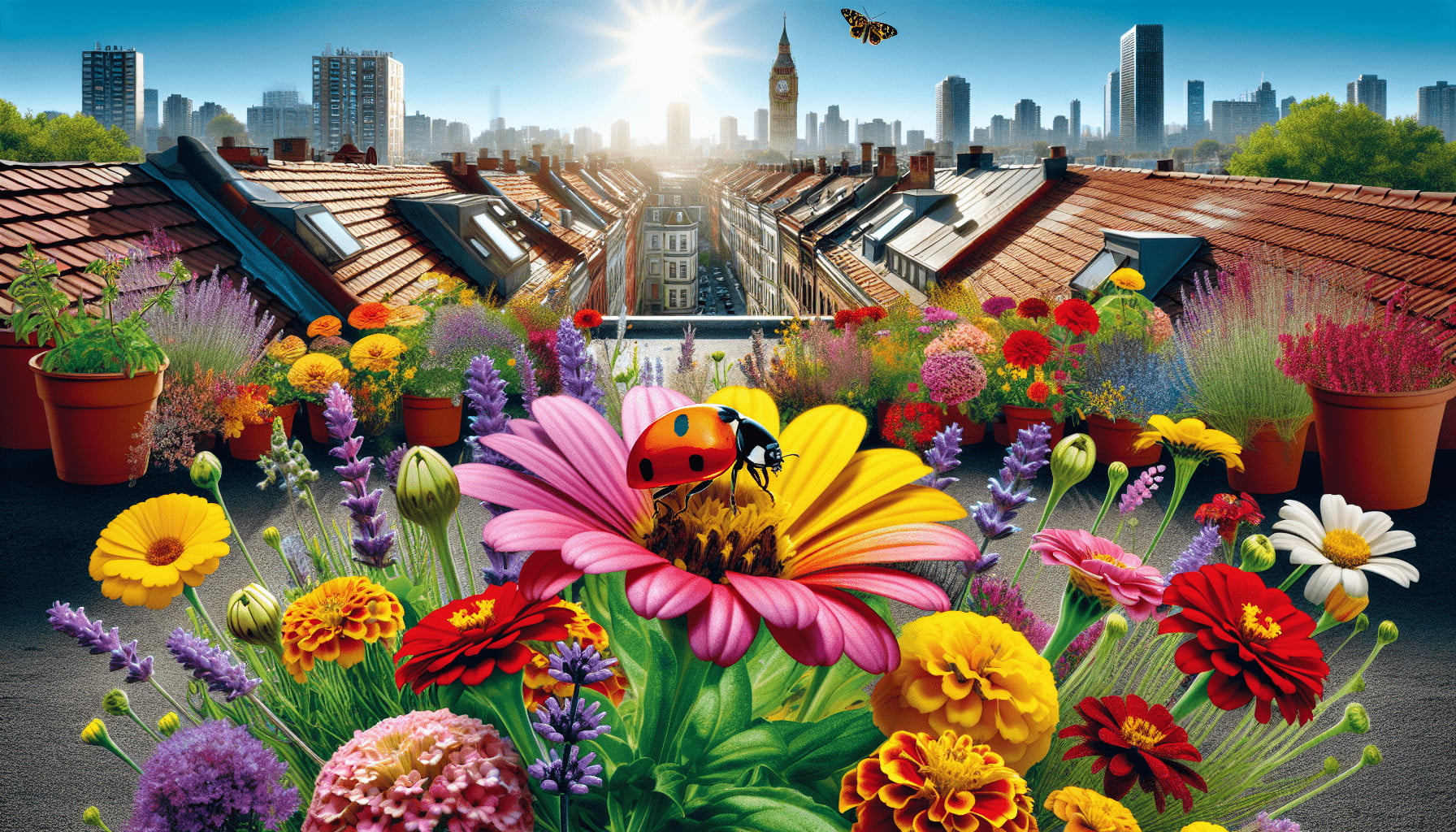Have you ever wondered how you can transform your rooftop garden into a thriving ecosystem filled with beneficial insects? Whether you’re a seasoned gardener or just getting started with your green space, attracting these helpful creatures can make a significant difference in maintaining a healthy and productive rooftop garden. Beneficial insects not only assist with pollination but also help control pests, reducing the need for chemical interventions.
In this comprehensive guide, we’ll explore five essential tips for attracting beneficial insects to your rooftop garden. By following these steps, you’ll create an inviting environment for these natural allies, fostering a balanced and sustainable garden. So, let’s get started on making your rooftop garden a haven for beneficial insects!

Understanding Beneficial Insects
Before diving into the specifics of attracting beneficial insects, it’s crucial to understand which insects are beneficial and why they are essential for your garden. Beneficial insects fall into several categories, each playing a unique role in your garden’s ecosystem.
Types of Beneficial Insects
Pollinators: These insects, such as bees, butterflies, and hoverflies, help plants reproduce by transferring pollen from one flower to another.
Predators: Predatory insects like ladybugs, lacewings, and predatory beetles feed on harmful pests, thus controlling pest populations naturally.
Parasitoids: These insects, including certain types of wasps, lay their eggs on or inside pests. Their larvae feed on the host, eventually killing it.
Decomposers: Insects such as certain beetles and flies break down organic matter, enriching the soil and promoting healthy plant growth.
By attracting a variety of these beneficial insects, you can create a balanced and thriving rooftop garden.
Tip 1: Plant a Diverse Range of Flowers and Plants
A diverse garden is an inviting garden for beneficial insects. Planting a variety of flowers and plants can provide food and shelter for these insects throughout the year.
Choosing the Right Plants
When selecting plants for your rooftop garden, consider including species that cater to the different needs of beneficial insects. Here are some suggestions for each type of beneficial insect:
| Beneficial Insect | Preferred Plants |
|---|---|
| Pollinators | Lavender, Sunflowers, Marigolds, Echinacea |
| Predators | Dill, Fennel, Yarrow, Alyssum |
| Parasitoids | Queen Anne’s Lace, Carrot Flowers, Parsley |
| Decomposers | Organic Matter (Compost), Mulch, Leaf Litter |
Planting in Layers
Think about layering your plants to provide a suitable environment for various insects. Groundcovers, low-growing plants, shrubs, and taller plants can create a diverse habitat that supports different insects. This approach not only adds visual interest to your rooftop garden but also ensures that various beneficial insects find a welcoming home.
Blooming Periods
Aim to have flowers blooming throughout the seasons. Planting species with staggered blooming periods ensures that beneficial insects have a continuous food source, attracting them to stay in your garden.
Tip 2: Provide Water Sources
Like all living creatures, insects need water to survive. Offering water sources in your rooftop garden can be a magnet for beneficial insects.
Creating Water Sources
Simple ways to provide water include:
Shallow Dishes: Place shallow dishes of water around the garden. Adding pebbles or small stones can help insects land safely and drink without the risk of drowning.
Bird Baths: Bird baths can serve as dual-purpose features in your garden, attracting both birds and insects.
Water Features: Small fountains or ponds can attract a variety of beneficial insects. Ensure there are landing spots, such as floating plants or stones, where insects can safely access water.
Regularly clean and refill these water sources to prevent stagnation and mosquito breeding.
Tip 3: Create Bug Hotels and Shelters
In addition to food and water, beneficial insects need shelter to rest and reproduce. Providing bug hotels and natural shelters can make your rooftop garden more enticing.
Constructing Bug Hotels
Bug hotels can be easily constructed using recycled materials such as wood, bamboo, and twigs. Here’s a step-by-step guide to building a simple bug hotel:
- Choose a Frame: Start with a wooden frame or box.
- Gather Natural Materials: Collect various natural materials like straw, twigs, pine cones, and bamboo sticks.
- Layer and Arrange: Layer and arrange these materials inside the frame, creating gaps and tunnels.
- Position the Hotel: Place the bug hotel in a sheltered, sunny spot away from strong winds and rain.
Providing Natural Shelters
In addition to bug hotels, consider maintaining natural shelters in your garden:
- Leaf Litter and Mulch: Allowing some leaf litter and mulch to remain undisturbed can provide a habitat for decomposers and other beneficial insects.
- Rocks and Logs: Placing rocks and logs in your garden can create hiding spots for predators and decomposers.
- Dense Plantings: Dense and layered plantings can offer shelter and breeding grounds for various insects.

Tip 4: Avoid Harmful Chemicals
Chemical pesticides and herbicides can be detrimental to beneficial insects. Reducing or eliminating the use of these chemicals is crucial to attracting and sustaining beneficial insect populations in your garden.
Integrated Pest Management (IPM)
Adopt Integrated Pest Management (IPM) practices to maintain a healthy garden:
- Monitor Regularly: Keep an eye on pest populations and plant health.
- Identify Problems: Correctly identify pests and beneficial insects.
- Cultural Controls: Implement practices such as crop rotation, plant diversity, and proper watering.
- Mechanical Controls: Use physical barriers like netting or manually remove pests.
- Biological Controls: Introduce beneficial insects as natural pest control.
Natural Remedies and Biopesticides
When pest control is necessary, consider natural remedies:
- Neem Oil: Effective against various pests and is safe for beneficial insects when used appropriately.
- Insecticidal Soaps: Target pests without harming beneficial insects.
- Companion Planting: Planting certain species together can deter pests naturally.
Tip 5: Educate Yourself and Observe Your Garden
Continually educating yourself about beneficial insects and their behaviors will help you create a more effective and welcoming environment for them. Observing your garden regularly can provide insights and help you make necessary adjustments.
Keeping a Garden Journal
Maintaining a garden journal can be an excellent way to track your efforts and observe patterns:
- Record Planting Dates: Note when and where you plant various species.
- Monitor Insect Activity: Document the presence and behavior of beneficial insects.
- Track Pest Populations: Keep a record of pest occurrences and control measures taken.
- Adjust Practices: Use your observations to make changes and improvements.
Joining Gardening Communities
Connecting with other gardeners can provide valuable tips and shared experiences. Join local gardening clubs, online forums, or social media groups to exchange knowledge and learn from others.
Continued Learning
Stay informed about new research and techniques in sustainable gardening and pest management. Books, online courses, and webinars can be great resources.
Conclusion
Attracting beneficial insects to your rooftop garden is an enriching endeavor that promotes a healthy and sustainable garden ecosystem. By planting a diverse range of flowers and plants, providing water sources, creating shelters, avoiding harmful chemicals, and continually educating yourself, you can create an inviting environment for these natural allies. Beneficial insects will not only help with pollination and pest control but will also enhance the beauty and vitality of your rooftop garden. Happy gardening!
